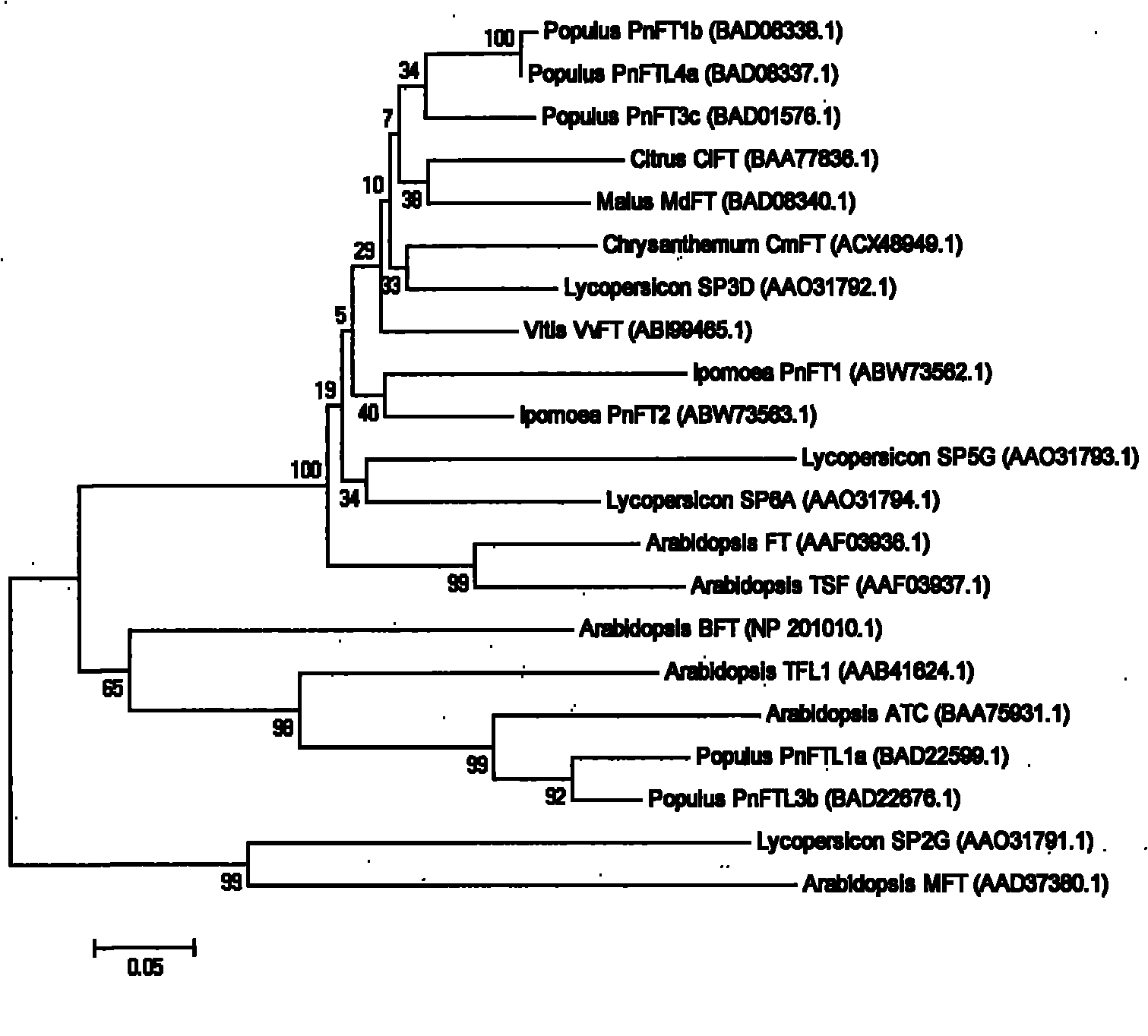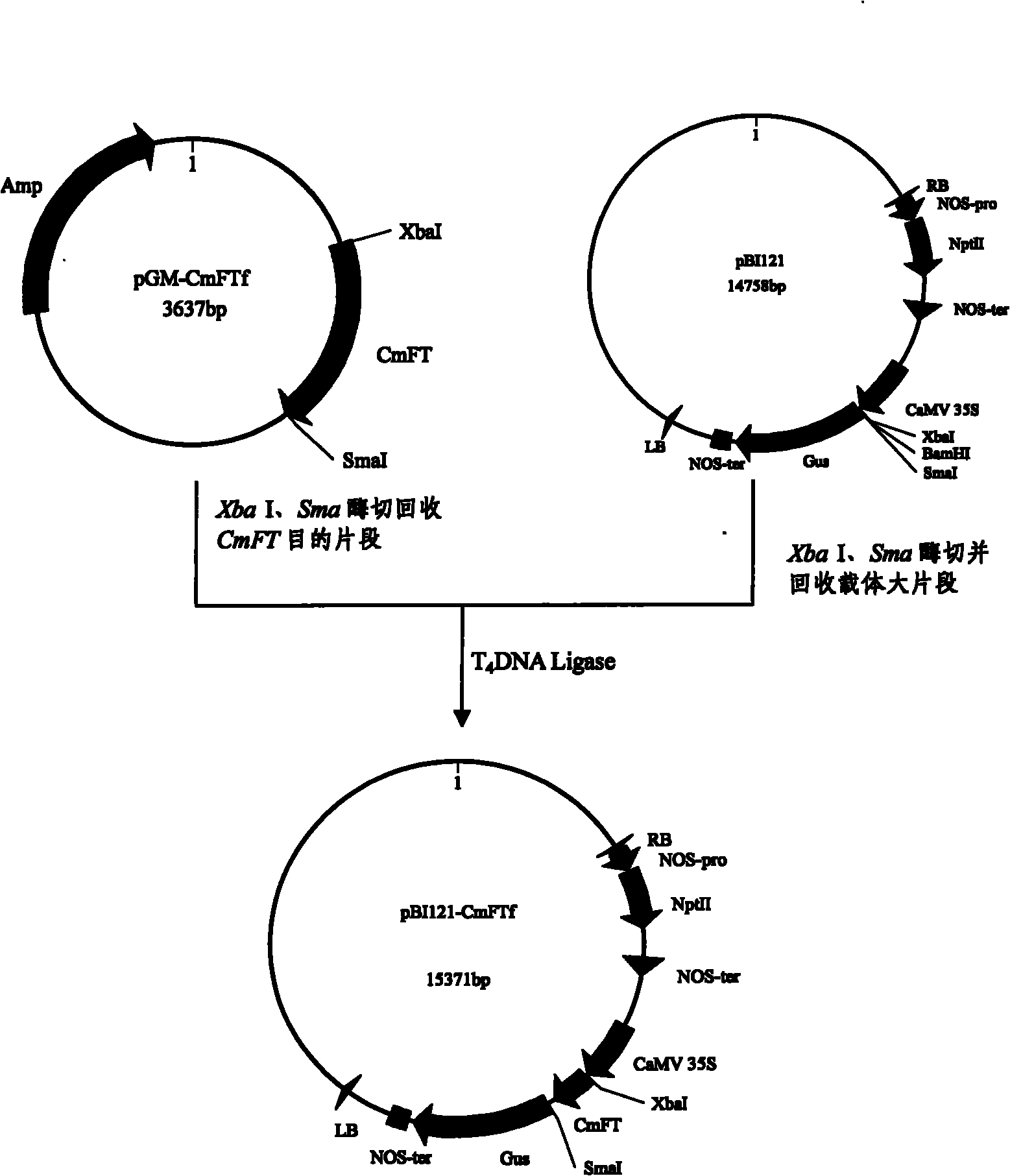Chrysanthemum photoperiod-sensitive gene and application thereof
A technology of photoperiod and chrysanthemum, applied in application, genetic engineering, plant genetic improvement, etc.
- Summary
- Abstract
- Description
- Claims
- Application Information
AI Technical Summary
Problems solved by technology
Method used
Image
Examples
Embodiment 1
[0029] Example 1.Isolation and Identification of CmFT Gene
[0030] method
[0031] 1. Material selection
[0032] The mixture of test material leaves and flower buds was taken from the groundcover chrysanthemum variety 'Jiyue Taohua' and stored in a -80°C ultra-low temperature refrigerator for later use.
[0033] 2. Design primers
[0034] Except for the universal primers in the RACE test, which are included with the kit (3'RACE universal primer sequence is shown in the 3'Full RACE Core Set Ver. The following table.
[0035]
[0036]
[0037] 3. Extraction and electrophoresis analysis of total RNA and DNA
[0038] A. Extraction of total RNA (using liquid nitrogen grinding method)
[0039]1) Take 500 μL of lysate RLT, transfer it into a 1.5 mL centrifuge tube, add 5 μL of β-mercaptoethanol to a final concentration of 1%, then add 50 μL of PLANTaid and mix well for later use.
[0040] 2) Grind an appropriate amount of plant tissue (the mixture of leaves and flower b...
Embodiment 2
[0115] Example 2. Genetic transformation of CmFT gene
[0116] Using the plant expression vector pBI121 as the basic skeleton, the sense and antisense expression vectors of CmFT were constructed, which were named pBI-CmFTf and pBI-CmFTr respectively. The sense expression vector pBI-CmFTf introduces specific restriction sites Xba I and Sma I at both ends of the target gene, and the antisense expression vector pBI-CmFTr introduces reverse restriction sites Sma I and Xba I at both ends of the target gene. RT-PCR amplifies the target gene CmFT with high fidelity, connects it to the pGM-T intermediate vector, double-digests pBI121 and the intermediate vector respectively, recovers the large fragment of the vector and the target fragment, and then performs directional sticky end-blunt end ligation and enzyme All identification.
[0117] 1. Amplification of the target fragment
[0118] According to the CmFT gene sequence, two pairs of sense and antisense primers containing Xba I an...
Embodiment 3
[0185] Embodiment 3. to the application of light-sensitive gene CmFT
[0186] 1. Import CmFT into Arabidopsis for functional verification
[0187] Arabidopsis thaliana (A. thaliana ecotype Columbia) was used as the transformation population, and it was planted in a mixed growth medium of peat and vermiculite (volume ratio 1:1) at a culture temperature of 22-24 °C and a humidity of 60-70%, the light cycle is 16h / 8h (light / dark), and the light intensity is 3000lux in the light incubator. The Agrobacterium strain LBA4404 of the constructed plant expression vector pBI-CmFTf was transformed into the model plant Arabidopsis thaliana by flower organ soaking method, the resistant plants were screened, and molecular identification and phenotype analysis were carried out.
[0188] 1) Using Arabidopsis total DNA, negative control wild-type Arabidopsis total DNA, and positive control plasmid DNA as templates, design a pair of specific primers CmFT-GUS1: CAGCGACAACAGGAGCACAG and CmFT-GUS2...
PUM
 Login to View More
Login to View More Abstract
Description
Claims
Application Information
 Login to View More
Login to View More - R&D
- Intellectual Property
- Life Sciences
- Materials
- Tech Scout
- Unparalleled Data Quality
- Higher Quality Content
- 60% Fewer Hallucinations
Browse by: Latest US Patents, China's latest patents, Technical Efficacy Thesaurus, Application Domain, Technology Topic, Popular Technical Reports.
© 2025 PatSnap. All rights reserved.Legal|Privacy policy|Modern Slavery Act Transparency Statement|Sitemap|About US| Contact US: help@patsnap.com



